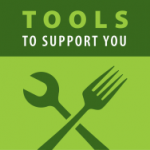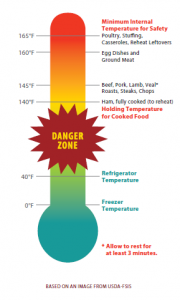You can tell volunteers over and over again what they need to do. Once you put [the hand washing sign] up on the wall, they see it, they comment on it, and they are constantly reminded what they need to do. – Chris Kane, Saint Vincent de Paul Food Pantry
You can help keep donated food safe by transporting them to your pantry in a food-safe environment. Handling and storing foods in the proper way will help keep food safe for guests to enjoy. Proper temperature control is key for maintaining the safety of perishable foods such as fresh produce, prepared meals, meats and eggs, and dairy. The Danger Zone is the range of temperatures between 40°F and 140°F. This is the temperature range at which harmful bacteria grow most rapidly.
Prepared meals that are delivered hot to the food pantry, or that you are transporting, must be kept hot, 140°F or higher, or cold to 40°F. Harmful bacteria will not grow as long foods are kept either too hot or too cold.Keep Hot Foods Hot
Help keep hot foods hot by placing them in a warming tray on a serving line. Cover with foil or a lid to help maintain temperature and prevent the food from drying out. If you are reheating casseroles or other dishes, cook at a temperature of 165°F, then keep warm, at 140°F or higher. Do not use a slow cooker to re-heat foods. A slow cooker does not heat up fast enough to warm foods that are cool or room temperature, but these appliances can be
excellent ways to prepare soups and stews from scratch.
Keep Cold Foods Cold
Keep perishable foods such as meats, eggs, and dairy products cold, stored at 40°F or below. An acceptable temperature for a refrigerator is 32° to 40°F. A freezer should be set to -10°F, or even colder. Foods that require refrigeration should not be out of cold temperature storage for more than 2 hours.
Transport Food Safely
In addition to keeping hot food hot and cold food cold, food safety when transporting food. Whether it’s remembering to pack ice packs that you will need, having a clean vehicle (leave the pets at home for this trip), or planning a driving route that will keep food from sitting out of refrigeration too long, food safety is key when transporting food.

Policy for accepting and transporting foods
Repackaging bulk food product policyHandle and Store Food Safely
Storing food safely is essential. Whether maintaining the proper temperature for perishable foods or having a clean pantry environment, food pantries maintain the safety of food in their care. A health policy for volunteers, a policy on sanitation, or a policy on food repackaging can all help to ensure that food that you have worked hard to source remains safe to distribute.
Maintain a well-kept food-safe pantry
Safe food for those you serve health policy




